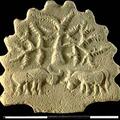Fuchsite Drinking Glass
Mark Kenoyer writes: "One famous stone vessel found at Mohenjo-daro is a tall glass with concave sides that is similar in shape to ritual columns found in Balochistan and Afghanistan. This green stone, called fuchsite, is rare, but it can occur with quartzite which is common throughout Balochistan and Afghanistan. When this fuchsite vessel was first examined by a geologist in the 1930's, the only know source was Mysore State, over 1600 km south of the Indus Valley.










